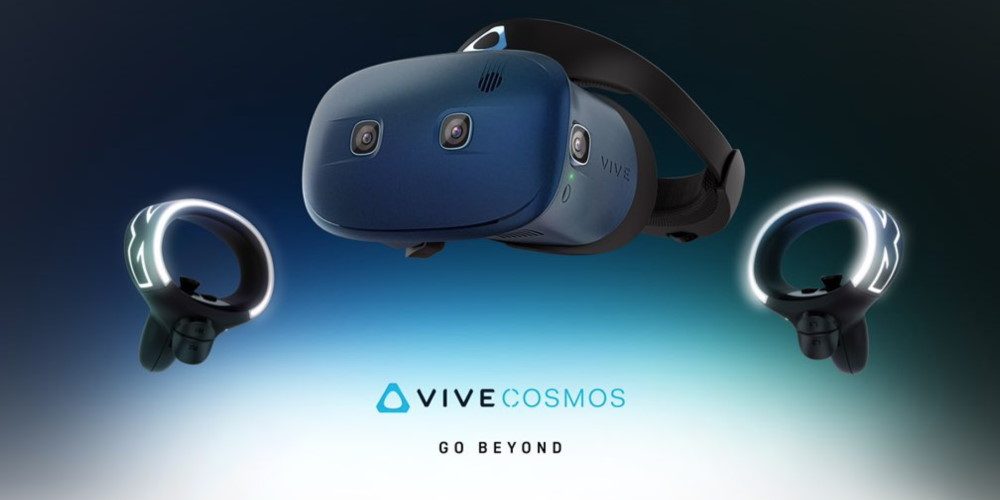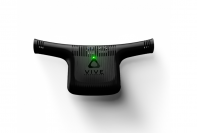Virtual reality is evolving at a very rapid pace.
Every now and then, one of the tech-giants comes up with a new option that claims to be better than any other in the market.
Since it was launched, virtual reality has always amazed its users.
It has completely changed the basic concept of computer-oriented software and games.
Who would have thought that playing a certain game while being a part of it would ever be possible?
How would it have been possible to experience the unimaginable, right from the comfort of your own home?
It is due to the invention of virtual reality and the concerted effort to improve the experience for its users.
The big names in the market want to bring out the best VR material for its users, including headsets and content.
HTC has had a major role in introducing VR equipment and content.
HTC has announced the release of a series of four VR headsets.
HTC Cosmos is the basic headset. Cosmos Play, Cosmos Elite, and Cosmos XR are in the series.
You can upgrade or downgrade your headset with the swappable faceplates.
The goal is to let the consumers enjoy headsets with different features based on their needs.
You can purchase the basic HTC Cosmos and then buy additional faceplates to upgrade it, when required.
HTC has created each headset by targeting audiences from different levels.
It has something to offer everyone, ranging from a beginner to an expert.
Has HTC been able to live up to the expectations of its users? With several competitive models already being offered, the bar has already been raised for the HTC Cosmos.
The latest series of HTC Cosmos are successors to the PC-tethered HTC Cosmos model that was released last year.
HTC has used the same modular design language and technology that was found in the original Cosmos headset.
This could be HTC’s strategy to make the headset popular and user-friendly.
We will simplify our discussion of the four headsets.
The basic headset model is the same.
It is the swappable faceplates that offer distinctive features for different headsets in the series.
We will the basic HTC Cosmos in detail as well as the other models in the series.
Release date and price
The original HTC Cosmos was released in October 2019.
It can be purchased for $699.
The other models were scheduled to be released by March 16th, 2020.
The basic model includes a base plate with a six-camera tracking faceplate.
Things get a little tricky at this point.
Every faceplate costs an additional $200 and is expected to be available once production gets back to normal.
It has been interrupted by the coronavirus outbreak.
However, things are soon expected to be under control.
HTC Cosmos is expected to cost $899.
To put things in perspective, the HTC Valve Index is a more expensive VR headset that is priced at $999.
This is almost $100 more than the price of the complete HTC Cosmos Elite package.
By contrast, HTC Vive is available for $399, which is $300 less than the standard HTC Cosmos headset.
HTC Cosmos Play is meant for novice level users and is expected to be released after the HTC Cosmos Elite. It will be available for $500.
The pricing for the two soon to be released HTC headsets provide an idea about the cost of the HTC Cosmos XR.
This particular headset is meant for developers and expert level users.
The price and release date have not yet been announced.
HTC Vive Cosmos Design and Specifications
All of the headsets in the HTC Cosmos series follow the same basic design features.
You can expect to be pleased by the sharp display, great audio and an app that offers many amazing games.
However, HTC lags in other areas like comfort, tracking and bulky controllers.
It seems unfair that at such a high price, consumers have to deal with these flaws in the design.
HTC Cosmos looks like something out of a science fiction movie.
It has blue colored hollow triangles spread across the faceplate.
Four cameras are located on the four sides of the faceplate.
Two additional cameras are present on either side of the goggles.
The power button and an LED light are located on the left side of the headset, while the knob for adjusting interpupillary distance can be found on the right side.
Inside of the headset there are two giant lenses, with a sensor built above and between them.
The interior is cushioned to give extra comfort and support to the face during long hours of gameplay.
Additional padding is provided for the nose.
This padding helps to keep any light from seeping in from the gap that is underneath the nose.
The headset is to be fixed on the head by a halo strap with a wheel at the back for tightening or loosening the strap.
This means that the weight of the headset rests at the front.
This can get uncomfortable after a while.
The headset has two small earphones and a 16.4-foot long cable that is connected to the Displayport.
This headset weighs 1.5 pounds and measures 7.5 x 4.6 x 5.6 inches, which is heavy compared to other headsets in the market.
HTC Cosmos offers a 3.4-inch, 2880 x 1700 resolution LCD with a refresh rate of 90Hz.
There is an 1440 x 1700 image per eye.
This resolution is higher than both the Valve Index (2880 x 1600) and the Oculus Rift S (2560 x 1440).
This means that the screen door effect with HTC Cosmos is not noticeable.
One feature that may be disappointing for users, is that the lenses cannot be moved forward and backward.
This restricts the field of view and also hinders the immersion.
The HMDs in the headset can be lifted to see the outside world.
In the same way, the two cameras present at either side of the goggles feature a pass-through mode.
This mode can be accessed, by pressing the button twice in any app or game.
However, in case of sickness, it is best to lift the flap.
HTC Vive Cosmos Setup
HTC Vive Cosmos is easy to set up, unless you are scared by a lot of wires.
After you are done connecting the wires, download the Vive Software app from HTC’s website.
You should then head to the Viveport website and download the VivePort app.
This will give you access to HTC’s games library.
This may take up to 8 Gb of space on your PC.
The next step is to connect your DisplayPort to the Link box.
You must ensure that all the output cables are connected to the right ports.
The controllers require 4 AA batteries that come with the package.
The recommended play area is 6 feet by 6 inches by 5 feet.
You can customize the play area, which is an interesting feature.
The tutorials are short and brief.
However, they cover all the information required to use the HTC Vive Cosmos headsets.
The tutorials provide some nice gadgets for you to get the hang of it.
HTC VIVE Cosmos interface
After you have gone through the verbal instructions, you can begin to enjoy the VR experience.
The basic experience is not as immersive, since you cannot completely customize your personal space called the Origin.
It is easy to navigate through the menus in the HTC Vive Cosmos.
It has three basic tabs.
One tab takes you back to the origin.
The second tab takes you to the list of games and apps that HTC has to offer, and the third tab is for settings.
You can adjust the volume, the display mode of the lenses, and enable or disable the passthrough camera mode.
You can adjust the distance and height of the lens, as required by each game and can also change your boundary setting through this settings tab.
HTC Vive Cosmo Performace
This is the main area of concern when buying a VR headset.
Unfortunately, HTC Cosmo has been a disappointment.
The high price considering the subpar tracking is not justified.
The games that involved rouge-like gameplay, are fun to play.
However, the games that require sitting in one place and playing are a nightmare, due to the tracking issues of the controllers and the headset.
The full action games that must be played while standing up are better.
However, there are still tracking issues, particularly when the movements are full-scale.
The tracking is the worst when playing the game called Arizona Sunshine.
HTC needs to do something to fix its tracking game.
It is quite likely that HTC uses a predictive algorithm for tracking.
This algorithm guesses where your hands should be at a particular point in a game.
While this guessing game works well with the games that require minimal hand movements, it ruins the experience of other games.
The games look sharp in a 3D display.
The screen door effect is almost negligible and the refresh rate at 90Hz makes it comfortable to play VR games for many hours.
The recommended specs for HTC suggest that you should use an Nvidia GTX 1060 / AMD Radeon RX 480 or greater GPU, Intel i5-4590 / AMD FX 8350 or greater CPU and at least 8GB of memory.
HTC Vive Cosmo controller
If you remove the cool touch functionality from the oculus controllers, you will be left with HTC Vive controllers.
These controllers come in pairs.
They each have a thumbstick, two face buttons, a menu button, bumper, trigger,and a grip button.
Each controller weighs around 7.2 ounces and comes with a lanyard.
The controllers are rather bulky. However, the button layout is commendable.
The pair of face buttons and analog stick are located at a good distance from each other, with the menu buttons under the analog stick.
This prevents the accidental smashing of the menu buttons.
The controllers look ergonomic. However, they can use a little curve.
This is because the palms can cramp up during long hours of gameplay.
HTC Vive Cosmos Audio
The built-in earphones are not without fault.
However, they are small powerhouses that promise sharp and loud sound.
The earphones completely cover the ears and the sounds within the game sound satisfying.
This is due to the great audio that the headset has to offer.
The speakers can deliver high string notes to low bass sounds.
They allow you to clearly distinguish between the notes.
You can also detach the speakers and replace them.
HTC Vive Cosmos Games and App Library
HTC Vive Cosmos suffers from the situation as the other headsets.
They do not have a rich library of AAA VR games.
HTC Cosmos also does not yet have a flagship game like other counterparts.
However, Vive has an excellent monthly paid service called the VivePort infinity.
If you want access to a wide variety of games and apps, you can get it through Vive.
The VivePort membership is or $12.99 a month, or $8.00 if you choose an annual plan.
The service offers many enjoyable games, like Creed, Arizona Sunshine, Rise to Glory, and Five Nights at Freddy’s VR.
You can get access to other games that are offered outside the service, at an additional cost.
Some interesting apps like Tilt Brush and the Firefox web browser in VR are also available, along with several original series, like Whale Encounters.
HTC Vive also has educational apps. Some excellent apps are The Night Café and the Circadian Rhythm.
Is it Comfortable for Long Hours of Gameplay?
It is not comfortable for long hours of gameplay.
With several lightweight and sleek headsets available in the market, the bulky headset by HTC is a disappointment.
The price does not justify why HTC has not paid more attention to the comfort and appearance of this headset.
The halo-strap design makes the headset feel bulky.
Most of the headset’s weight is on the front of the head.
The halo-strap also feels annoying and uncomfortable against the skin.
It leaves an imprint after long hours of gameplay.
Focusing on the center of the lens is difficult.
The good thing about the headset’s design, is that you can flip the screenif you want to see the real world.
After the detailed review of the basic HTC Vive Cosmos headset, we will next explore other headsets in this series.
As mentioned earlier, HTC has tried to target users from all experience levels and walks of life with this series of headsets.
Each headset comes with a distinctive set of specifications.
You can be an entry-level, novice VR user, an expert game developer, or anyone in between.
HTC has something to offer everyone.
Let us dive into the details of these headsets in the latest series.
HTC Vive Cosmos Play
HTC Cosmos Play is a basic, entry-level headset.
It does not offer any advanced features.
The price and release date are yet not confirmed.
The news leaked from HTC Vive said that Play was to be priced at $500.
However, this price has not yet been confirmed.
Since Play is the basic headset with the fewest features, it has four sensor cameras, compared to six on the HTC Vive Cosmos headset.
The room-scale tracking will not be as good as with the six-sensor cameras on the standard HTC Cosmos headset.
It will be compatible with the basic HTC Cosmos controllers.
This headset may not come with built-in earphones, however, it has a 3.5 mm headphone jack, where you can connect your headphones.
HTC Vive Cosmos
This is the standard flagship headset in the series.
This headset has been reviewed in detail earlier.
It is currently priced at $700.
HTC Vive Cosmos Elite
If you are looking for a headset with high-end advanced features, HTC Vive Cosmos Elite is your answer.
The headset is bundled with two external tracking faceplates, including a SteamVR tracking faceplate, two external tracking lighthouses, and two HTC Vive controllers.
These all come with the headset at a price of $900.
This headset is intended for VR enthusiasts.
SteamVR tracking is what makes this headset special.
It is the same tracking that is used in the basic Vive, except that SteamVR tracking requires additional base stations.
This type of VR tracking is considered to be the gold standard, because of the precision that it offers.
You will need to mount additional base stations around your room with this type of VR tracking.
Elite uses the standard VR wands as its controllers.
This may be disappointing to users, since these controllers still use the trackpad and grab buttons.
Elite is expected to be released on March 18th, 2020.
HTC may offer the steam VR tracking faceplate as a standalone accessory.
This will make it easy to obtain the external tracking faceplate and base stations and upgrade their existing headset from the series.
HTC Vive Cosmos XR
This one is the most complicated model in the series.
This is because it is targeted for the developer class.
It is aimed at pass-through augmented reality.
Augmented reality transmit the outside world into the screen of the headset and projects a virtual reality in the real world.
In some ways, it is opposite of the virtual reality.
However, the headset will also be capable of doing VR.
What makes the XR model different from all the other headsets, is that it has two purpose-built cameras on its faceplate that improve the pass-through experience.
The additional cameras sharpen the display and increase the field of view.
The issue of concern is the positioning of the additional cameras.
They appear to be below the eye-line of the user.
We will see how things unfold with the launch of the HTC Vive Cosmos XR.
The release date and price are still unknown.
The verdict
The HTC Vive Cosmos series demonstrates that HTC has put a great deal of thought into the idea of releasing a series of modular headsets.
However, the design, games, app library, comfort and price are not promising enough to take the VR market by surprise.
The high price could be due to the fact that HTC does not have the software that can ensure high profits.
It is depending on its hardware development to generate profits.
The idea of modular headset appears to be interesting and to offer the potential to save money.
However, once the calculations are done, it does not make much sense.
If you buy HTC Cosmos Play for $500 and want to upgrade it to Elite, you will be required to invest in the faceplate with six sensor cameras, the base station and the controllers.
As a result, the total cost will be higher than the actual price of the Elite.
The modular update only makes sense, when you wish to upgrade from Cosmos Play to Cosmos.
Therefore, the only headset that is worth investing in, is HTC Vive Cosmos Play.
It is expected to cost $500, which isn’t a high price for an entry-level headset.
You should evaluate your options and make a smart decision.



